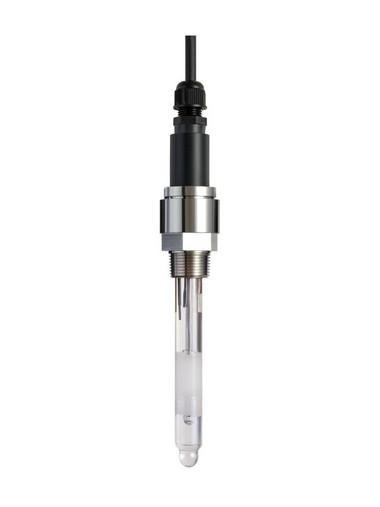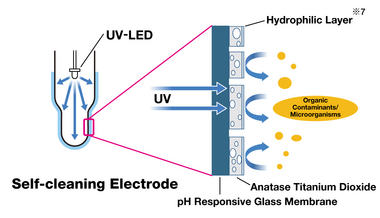[Kyoto, Japan] – A HORIBA, Ltd. group company HORIBA Advanced Techno Co., Ltd. has released the world’s first*1 Gel-filled Self-Cleaning pH Electrode using antifoul technology. HORIBA Advanced Techno Co., Ltd. has high reputation in water quality monitoring and analysis instrumentation business.
The sewage and wastewater treatment plants utilize activated sludge*3 for their water cleaning process operation and it requires pH testing and condition management.
The new Gel-filled Self-Cleaning pH Electrode has photocatalyst technology (anatase titanium dioxide)*4 leveraging discoveries made in joint research with Mie University (Tsu-city, Mie prefecture, Japan) and an ultraviolet light-emitting diode (UV-LED) built into the electrode. These proprietary HORIBA technologies*5 achieve an antifouling effect against organic contaminants and realize stable continuous measurements in wastewater treatment processes where electrodes easily become soiled.
These innovations dramatically reduce the frequency and labor required for electrode maintenance (up to approx. 99%*6 reduction) to not only alleviate the burden placed on users who clean, calibrate, and manually run analyses on a daily basis but also help overcome the challenge of on-site labor shortages.
The catalyst (anatase titanium dioxide) coating*5 and a UV-LED built into*5 the electrode realize the world’s first antifouling technology*1 in a pH electrode. More specifically, HORIBA has coated the surface of the glass membrane with anatase titanium dioxide and irradiates UV-LED light from inside of the electrode.
The anatase titanium dioxide reacts to the light and breaks down any organic contaminants on the surface of the glass membrane, such as oil, polysaccharide and microorganisms, through an antifouling effect.
This antifouling technology dramatically reduces the frequency of pH electrode maintenance. As a result, this new pH electrode has become able to eliminate up to approx. 99%*6 of the maintenance work typically necessary.
The catalyst coating technology that has been adopted for this electrode capitalizes on technologies discovered through joint research with Mie University.
Kentaro Inoue, the business owner of HORIBA Advanced Techno, describes this technology saying, “Dr. Masao Horiba, the founder of HORIBA, Ltd. which developed the first glass-electrode pH meter manufactured in Japan, advocated the invention of an electrode that never gets dirty. Using these words as an opportunity, we developed a self-cleaning pH electrode based on water quality measurement technologies cultivated for more than 70 years since our founding, discoveries made through joint research with Mie University, and meticulously scrutinized data obtained by visiting customer sites. I hope the product making our founder’s idea a reality will benefit many customers in addition to promote greener practices in industry at large.”
*1 As a glass-electrode pH meter based on internal research as of September 2022
*2 Gel-type electrode requiring no regular refill of inner solution
*3 Aggregation of microorganisms playing a role in removal of pollutants in sewage to clean water
*4 Japan Patent No.: 5121012/4876123/4824609; United States Patent No.: US8080315, US7976690
*5 Japan Patent No.: 7014652
*6 Compared to conventional HORIBA products; antifouling effect differs according to usage method and conditions
*7 A thin water layer spread over the glass generating an infinity for water that prevents the adherence of contaminants

